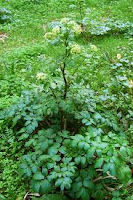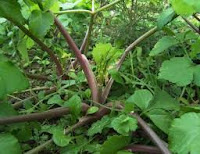Alexanders looks a lot like angelica, and is related to it as it is a member of the Apiaceae or Umbelliferae family. As such it is related to fennel, dill, sweet Cicely, cow parsley, lovage, carrots, caraway, anise, lesser and greater burnet saxifrage, water fennel or water dropwort and Thapsia to which it bears a strong resemblance with its yellow- green flowers. It originated in Europe and Asia and has naturalized in Britain
 It tastes a little like celery and the leaves are similar to those of this plant. The seeds are used as a condiment and all parts of the plant are edible. The flowering tops can be eaten and cooked like broccoli for which it can be a substitute. The unopened flower buds can be pickled and when this is done they look like mini-cauliflowers. The leaves and young shoots may be eaten raw in salads or cooked and added to soups or stews, which is what the Romans used them for. It is said that they introduced this plant to
It tastes a little like celery and the leaves are similar to those of this plant. The seeds are used as a condiment and all parts of the plant are edible. The flowering tops can be eaten and cooked like broccoli for which it can be a substitute. The unopened flower buds can be pickled and when this is done they look like mini-cauliflowers. The leaves and young shoots may be eaten raw in salads or cooked and added to soups or stews, which is what the Romans used them for. It is said that they introduced this plant to The stems can also be cooked like asparagus, steamed or boiled for 5 to 10 minutes, and served as a side dish. The plant grows in autumn and has leaves throughout the winter, so was a useful source of nourishment. It is said that if the root is left in a cool place over winter it becomes tender and is good in soups and stews. The stems are a little more pungent than celery and the seeds are peppery. The flower buds may be eaten raw in salads too.
In the past Alexanders was used to treat asthma, menstrual problems and wounds, but generally it is not used today, although there would seem to be no reason not to as it is not poisonous as plants such as aconite, thornapple (datura) and aak are.
Nicholas Culpeper, writing in the 17th century has this to say about it:-
 “Government and virtues. This plant is under Jupiter, therefore friendly to nature. The whole plant has a strong warm taste, and was more used in the kitchen than in the medicinal way, having been either eaten raw, as a sallad among other herbs, or else boiled and eaten with salt meat, or in broths in the spring season. The root pickled was deemed a good sauce, but its use in the kitchen has been entirely superseded by the cultivation of celery. It is reckoned to be of the nature of parsley or smallage, but stronger, and therefore may be serviceable in opening obstructions of the liver and spleen, provoking wind and urine, and consequently good in the dropsy or stranguary. For this purpose, half a drachm of the seeds powdered, and taken in white wine, every morning, is seldom known to fail. It is likewise good for bringing on the courses, and expelling the after-birth, notwithstanding it is seldom used in medicine.”
“Government and virtues. This plant is under Jupiter, therefore friendly to nature. The whole plant has a strong warm taste, and was more used in the kitchen than in the medicinal way, having been either eaten raw, as a sallad among other herbs, or else boiled and eaten with salt meat, or in broths in the spring season. The root pickled was deemed a good sauce, but its use in the kitchen has been entirely superseded by the cultivation of celery. It is reckoned to be of the nature of parsley or smallage, but stronger, and therefore may be serviceable in opening obstructions of the liver and spleen, provoking wind and urine, and consequently good in the dropsy or stranguary. For this purpose, half a drachm of the seeds powdered, and taken in white wine, every morning, is seldom known to fail. It is likewise good for bringing on the courses, and expelling the after-birth, notwithstanding it is seldom used in medicine.” It is known as black lovage because of the colour of the root and seeds, which are almost black when ripe. It flowers in Britain
Writing in 1640, Parkinson says that it was eaten during Lent to aid digestion and to digest “the viscous humours in the stomache.” Lenten pottage is an old Irish recipe which was eaten during Lent and which comprised nettles, watercress and Alexanders. Nowadays the seeds are crushed and added to vodka to give it some more oomph.
 It used to be called the herb of
It used to be called the herb of Alexanders is the centre of some research into the sesquiterpenoids all parts of the plant yield in their essential oil (2010 Papaioannou, F. et al). Sesquiterpene lactones from the plant have also been investigated in a study published in 2001 for their ability in vitro and in mice to kill cancer cells. More research needs to be done on this plant to discover what medicinal benefits it has for us.







































